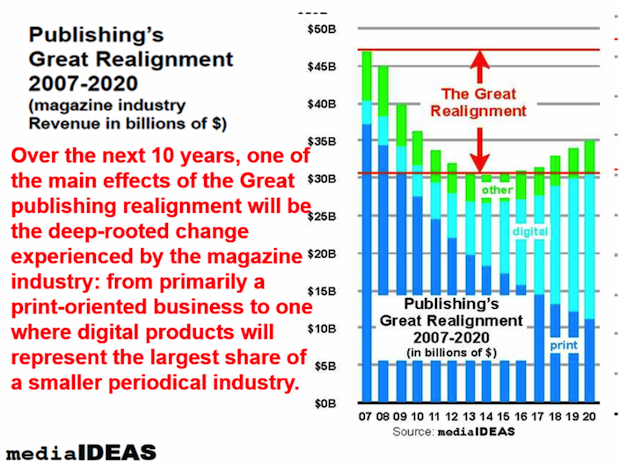An interesting professional sobriety hit the magazine business last week that was a long time in its maturation. The MPA moved us off the teat of accounting for print ad pages as our franchise enabler and instead offered a solution of cross-media oversight. Concurrent with this move was the decision to no longer make public the accumulated printed ad page stats. This move attempts to take the consistently depressing news about declining page counts off the front page and to make them available only to MPA members and their affiliates.
I understand the desire to camouflage the dissent, as the information is depressing and, I think, often times misleading. I have stated many times in this newsletter that trends do not reflect the specifics of individual titles or companies. Many print magazines are doing very well. But the overall trend of the industry continues to quickly head south.
To be honest, I was on a conference call with Mary Berner and the MPA on the Thursday prior to the Monday announcement. I congratulated Mary on her accomplishment of corralling 147 publishers into the deployment of a new system. It is a new approach and, as I see it, it has plusses and minuses. Where I completely agree is that something aggressive needed to be done. The plus is to change the dialog about the health of the print business, which is still the largest revenue producer for the magazine business, and to start to methodically discuss the totality of magazine media reach.
The possible negative result is that it broadens the arena of competition. Now we must face more directly the complex numbers game of other web based information providers besides traditional magazine publishers. A few that come to mind are The Huffington Post, Yahoo News, CNN, Buzzfeed, Upworthy, Facebook, Twitter and Tumblr, which said recently that it gets over 15 billion page views a month and reaches about 120 million users through its network of 42 million blogs. Although the digital portion of the magazine industry is growing rapidly at 97.9 percent over the same time in 2013, their total digital numbers are dwarfed by the digital upstarts.
If you pick a time in the future and you agree that eventually the majority of our profits will be from digital sources, this move still makes perfect sense. In 2007 my company mediaIdeas forecast just such an occurrence. We stated that by 2020 60% of the revenue of the magazine media industry would come from digital sources. That forecast still leaves 10 to 12 billion of revenue from print products in 2020, which although is a precipitous drop from the print revenues of 37 billion in 2007, it is at the same time a large enough number for many print publishers and print companies to happily share.
















